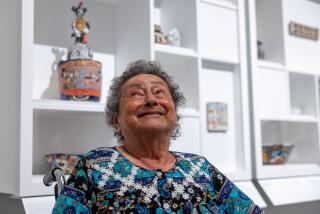Examining culture’s indelible mark
LONDON — Marisa Carnesky got her first tattoo -- a red squiggle on her back -- because in the Goth era all her friends were getting one. She was 19, away from home at the University of Brighton and immersed in alternative culture. But one tattoo is never enough, and soon she had a peacock etched on her left arm, and a lion and a tiger on her right arm.
She sensed this was all taboo, as a woman and as a Jew. Later, as she did some research, she saw that it was specifically prohibited by the Torah, which declared, “Ye shall not make any cuttings in your flesh for the dead, nor tattoo any marks upon you.” It was desecration of the body, and the body, after all, was on loan from God. There was also the prohibition against making “graven images.”
Here she was, a living embodiment of contradiction.
“I love decoration,” says Carnesky, 32, whose sleeveless chinoiserie blouse reveals her trellis of arm decorations. Seated at a work table in her modest studio in a working-class section of London, she pulls out a photograph to show the full-body tattoo she ended up getting. “But there was a conflict inside me -- I’m Jewish and I shouldn’t have done this, but am I Jewish, though? What does that mean to me?”
Half a dozen years later this thinking spun into a piece of theater that brings her to UCLA’s Macgowan Little Theater tonight and Friday through Sunday -- with the warning “For mature audiences only.” Carnesky solos in “Jewess Tattooess,” which deals with tattooing, the desecration of the body, the Holocaust and gender politics.
And it all started with a fascination with ballet.
“I always wanted to be a ballerina,” says Carnesky. “My mother used to take me to Sadler’s Wells, so I saw ballet in the style of the old Russian ballet -- an era of opulence and radical choreography.”
So at 15 she took a year of ballet, then switched to contemporary dance. But she found dance restrictive and not sufficiently political. “I wanted to play with ideas and text, very visually led ideas,” she says.
She went to the University of Brighton to pursue a degree in visual and performing arts. But finding work after graduation was difficult. “I worked in the cabaret circuit,” says Carnesky. “I did time as a table dancer and a stripper in the East End of London, which is not really a very nice environment for women.” She also performed in other theater and dance pieces.
In 1994, she visited New York, attracted by what she felt was the directness and heightened politics of American performance artists. But to get the funding to make her own work, Carnesky knew she would have to go back to England.
After returning to London, she made several full-length pieces including “Jewess Tattooess,” which she performed around the United Kingdom and Northern Europe. “It sits on the edge between performance art and theater,” says David Sefton, director of UCLA Live, who decided to take the show after seeing a tape. “It’s all considered a little bit weird, but the world of performance art seems to be embracing more interesting ways of telling stories.”
“Jewess Tattooess” launches UCLA Live’s International Theatre Festival, and Sefton likes how this highly personalized piece counterbalances more traditional offerings like the Globe Theater presentation of Shakespeare’s “Twelfth Night.”
Carnesky is aware that her material may prove discomforting to some sensibilities. The piece opens with a giant star of David on the ground; a bandaged figure slowly and mysteriously emerges from it. In an incantatory tone, Carnesky invokes the spirit of Lilith, the mythical first woman, and the women in Biblical history who were despised as “impure.”
“I prophesy the day when your daughters will discover me,” her Lilith proclaims. “They will break the shackles of shame, and I will rise amongst you once again.” And indeed there is a scene where Carnesky slowly unravels her bandages and reveals her own body in all its tattooed glory. Several stories are told -- inspired by readings, interviews and anecdotal tales Carnesky collected. She had heard, for example, that at the end of World War II, European ports were full of prostitutes, some wearing gloves to cover up the numbers they had been tattooed with at Nazi concentration camps.
In the show she recounts a story about just such a woman at a bar, and one day she’s approached by a tattooed man who offers her not money for sex, but needles and pigment to cover her number with another tattoo, that of a flower.
“I’m sure some people find my show shocking or offensive,” she says, “but I’m not doing it to be shocking or offensive. I’m doing it to discuss cultural identity.”
Since creating “Jewess Tattooess,” Carnesky has gone on to make another full-length solo piece, “The Girl From Nowhere,” which addresses diaspora and dislocation. But while she is immersed in creating new works of art, she is not planning to get more tattoos.
“There are many more-tattooed people than me, who have gone further than I have, but for me this is far enough,” she says. “It’s quite a lot to live with.”
*
‘Jewess Tattooess’
Where: Macgowan Little Theater, UCLA
When: Tonight, Friday, Saturday, 8 p.m.; Sunday, 7 p.m.
Price: $30
Contact: (310) 825-2101
More to Read
The biggest entertainment stories
Get our big stories about Hollywood, film, television, music, arts, culture and more right in your inbox as soon as they publish.
You may occasionally receive promotional content from the Los Angeles Times.










